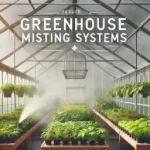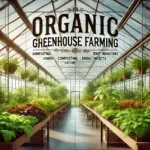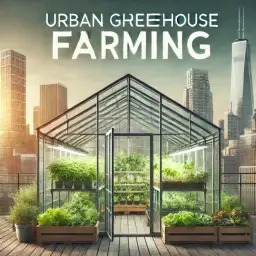Urban greenhouse farming involves growing plants in greenhouses within cities. This method is becoming more popular because it allows people to grow food locally and sustainably. It also helps reduce pollution, supports local jobs, and gives city people fresh fruits and vegetables.
What is Urban Greenhouse Farming?
Urban greenhouse farming involves growing plants inside a controlled environment within a city. These greenhouses can be found on rooftops, backyards, or inside buildings. The goal is to produce fresh, local food using sustainable methods.
Benefits of Urban Greenhouse Farming
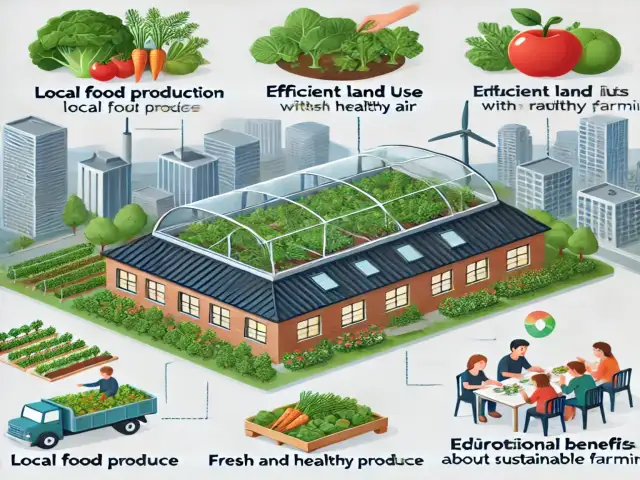
Urban greenhouse farming is a great way to grow plants in cities. It helps both people and the environment. Here are some of the main benefits:
Local Food Production
Growing food locally means the food can reach people easily. This reduces the need for transportation and lowers the carbon footprint, helping the environment.
Efficient Land Use
Using rooftops and empty spaces for greenhouses makes the best use of land in crowded cities. It turns unused areas into productive spaces for growing food.
Fresh and Healthy Produce
Urban greenhouses provide fresh fruits and vegetables in the city, allowing people to have healthier diets with fresh, nutritious food.
Environmental Benefits
Urban greenhouses help reduce pollution and improve air quality by growing plants that clean the air. This makes the city environment healthier for everyone.
Educational Opportunities
Greenhouses can be great learning tools. They teach people about sustainable farming and how to grow their food.
Economic Benefits of Urban Greenhouse Farming
Urban Greenhouse Farming Can Be Profitable
Growing plants in an urban greenhouse can make money. Here are some reasons why:
Higher Selling Prices
Organic fruits and vegetables often sell for more money than non-organic ones. People are willing to pay extra for healthy, chemical-free food.
Market Demand
Many people want fresh, local organic produce. This high demand means more customers are looking to buy from urban greenhouses.
Cost Savings on Chemicals
Urban greenhouse farming does not use chemical pesticides or fertilisers. This saves money because organic methods are cheaper in the long run.
Government Incentives
Some governments provide money to support urban farming. These financial aids can reduce the costs of setting up and running a greenhouse.
Direct Selling
Farmers can sell their produce directly to people at farmers’ markets or through community-supported agriculture (CSA) programs. This means they cannot share profits with intermediaries and can make more money.
Best Practices for Urban Greenhouse Farming
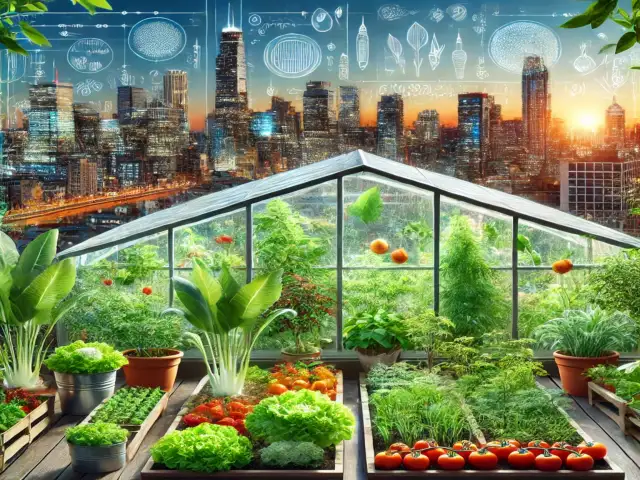
Following best practices is important for success in urban greenhouse farming. Here are some key tips to help your plants grow healthy and strong.
Proper Ventilation
Good airflow is very important. It helps control the temperature and humidity inside the greenhouse. Make sure your greenhouse has vents or fans to keep the air moving.
Regular Monitoring
Check your plants often. Look for pests, diseases, and nutrient levels. Regular monitoring helps you catch problems early and keep your plants healthy.
Using Organic Seeds
Use certified organic seeds. These seeds are not treated with chemicals and are better for your plants. Organic seeds help ensure that your plants grow strong and healthy.
Water Management
Proper watering is crucial. Drip irrigation systems are a good choice because they provide water directly to the plant roots and save water. Make sure your plants get the right amount of water.
Natural Pest Control
Use natural methods to control pests. Beneficial insects, like ladybugs, can help keep harmful pests away. Neem oil is a natural pesticide that protects your plants without harsh chemicals.
Soil Health Maintenance
Add compost and organic fertilisers regularly to keep your soil healthy. Compost provides nutrients that help plants grow, and organic fertilisers are safe and effective for maintaining soil fertility.
Technological Innovations in Urban Greenhouse Farming
Technology helps make urban greenhouse farming better and easier. Let’s look at some key technologies used in urban greenhouses.
Automated Climate Control
Automated systems help control the temperature, humidity, and light inside the greenhouse, ensuring that plants have the best conditions for growth.
Hydroponics and Aquaponics
Hydroponics is a way to grow plants without soil, using water with nutrients instead. Aquaponics is a system where plants and fish grow together. The fish provide nutrients for the plants, and the plants help keep the water clean for the fish.
LED Grow Lights
LED grow lights give plants the light they need to grow, even in places with little sunlight. These lights save energy and can be adjusted to give different plants the right light.
Community Impact of Urban Greenhouse Farming
Urban greenhouse farming has a big impact on local communities. It provides fresh food, creates jobs, and brings people together.
Job Creation
Urban greenhouses create farming, maintenance, and sales jobs, which help the local economy and give residents new opportunities.
Community Engagement
Greenhouses can be places where people come together to learn and share knowledge about farming. They become community hubs where people connect and support each other.
Food Security
Urban greenhouses provide a steady supply of fresh produce, improving food security by ensuring that everyone in the city can access healthy food.
Technology makes urban greenhouse farming more efficient and productive.
Sustainability Practices in Urban Greenhouse Farming
Sustainability is very important in urban greenhouse farming. Using sustainable practices helps protect the environment and ensures that farming can continue.
Water Conservation
Saving water is key. Drip irrigation systems help water go directly to plant roots without wasting it, and rainwater harvesting systems collect rain to use for watering plants.
Renewable Energy
Using renewable energy is good for the environment.
Waste Reduction
Reducing waste is important for sustainability. Composting plant waste turns it into useful nutrients for the soil. Using biodegradable materials means they will break down naturally without harming the environment.
Best Crops for Urban Greenhouse Farming
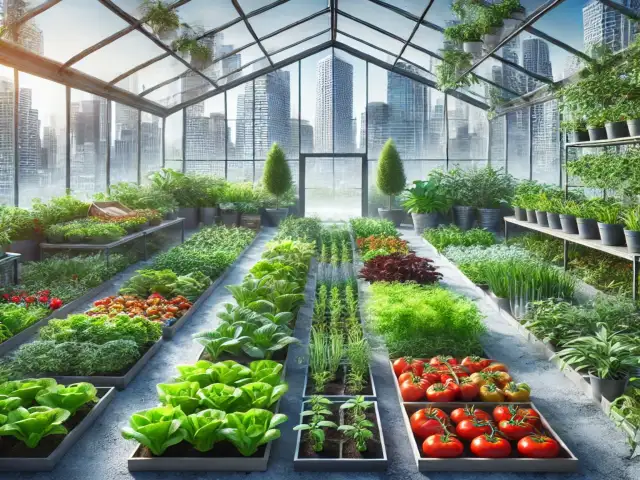
Here are some top choices for urban greenhouses:
Leafy Greens
Lettuce, spinach, and kale are excellent options. They grow fast and need little space, making them ideal for small urban greenhouses.
Herbs
Basil, mint, and cilantro are perfect for small areas. They flourish in greenhouses and add great flavour to meals.
Tomatoes
Tomatoes require a stable environment to grow well. Greenhouses provide the perfect conditions for them with controlled temperature and humidity.
Peppers
Sweet and hot peppers do very well in greenhouses’ consistent climate. They need warmth and care, making greenhouses perfect for their growth.
Strawberries
Strawberries are great for container growing. They need a lot of light, which greenhouses can supply, making them a delicious choice for urban farmers.
Challenges of Urban Greenhouse Farming
Urban greenhouse farming offers many benefits, but it also has its difficulties. Here are some main challenges that urban farmers might encounter:
Limited Space
Urban areas often lack space for greenhouses, and finding enough room to set one up can be tough in busy cities.
High Initial Costs
Starting an urban greenhouse can be costly. Land, materials, and construction expenses can quickly add up, making it a significant investment.
Maintenance
Greenhouses need regular upkeep to maintain a controlled environment. Plants require the right temperature, humidity, and care to thrive, which means ongoing work.
Pest Control
Keeping pests away without chemicals can be challenging. Using natural methods to manage pests and avoid harmful chemicals in urban settings is crucial.
Pest Control in Urban Greenhouse Farming
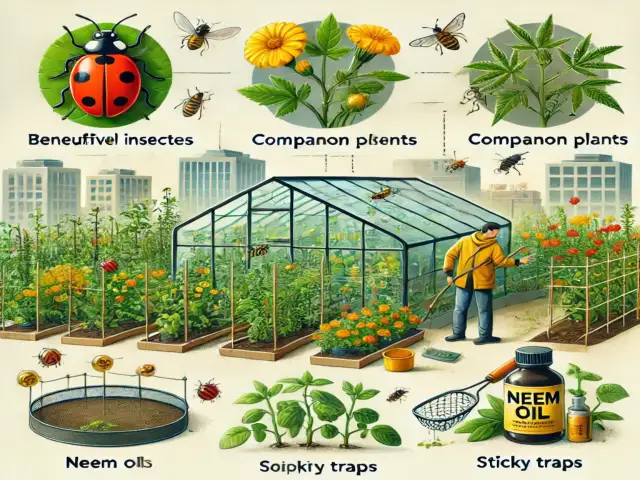
Here are some natural ways to control pests:
Beneficial Insects
Introducing beneficial insects like ladybugs can help manage pest populations. Ladybugs eat harmful insects, which helps keep plants healthy.
Companion Planting
Planting certain plants together can help deter pests. For example, planting marigolds near other plants can keep aphids away. This method is known as companion planting.
Neem Oil
Neem oil is a natural pesticide made from the neem tree. It can be safely used in greenhouses to protect plants from pests.
Sticky Traps
Sticky traps can catch flying pests such as flies and aphids. Placing these traps around the greenhouse helps monitor and reduce pest numbers.
Handpicking
Regularly inspecting plants and removing pests by hand is simple and effective. This helps keep the plant environment healthy without the use of chemicals.
Cost Implications of Urban Greenhouse Farming
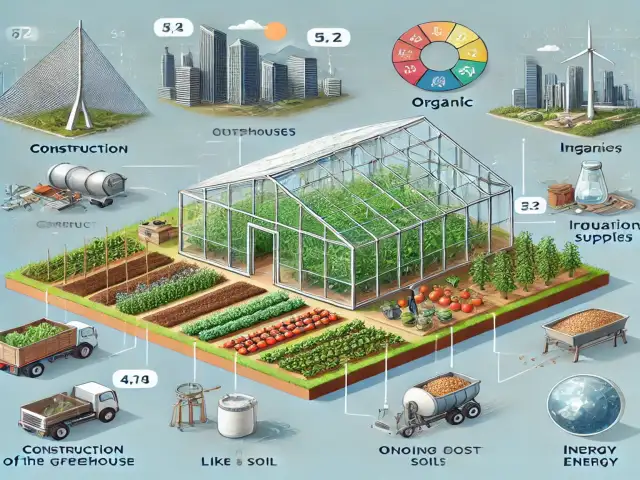
Understanding the costs involved is critical when planning an urban greenhouse. There are both initial setup costs and ongoing maintenance expenses.
Initial Costs
- Greenhouse Construction
- Building a greenhouse requires a significant investment.
- Organic Supplies: Organic seeds and soil tend to be more expensive than their non-organic counterparts, but they are necessary for starting a successful farm.
- Irrigation System: Installing a suitable irrigation system is essential for proper plant watering. This can be a considerable expense.
Ongoing Costs
- Labor Costs: Organic farming is labour-intensive. You must hire workers to help with planting, weeding, and harvesting.
- Energy Costs: Operating a greenhouse consumes energy for heating, cooling, and lighting. These costs can accumulate over time.
- Maintenance Costs: Regular maintenance is crucial to keep the greenhouse in good shape.
Urban greenhouse farming is a great way to grow fresh food in cities. Using organic methods and good farming practices, urban greenhouses can provide healthy food, help local economies, and protect the environment. Even though there are challenges, the benefits make urban greenhouse farming worth it.




